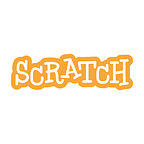Scratch Day Physical World Activity
Makey Makey Music
By Saskia Leggett
Scratch Day’s festive atmosphere presents a great opportunity to connect Scratch with the bright colors, fun sounds, and curious objects of the physical world. By pairing Scratch with the Makey Makey, a separate piece of hardware that can be purchased online, participants can use any conductive object — like a banana, a spoon, or another person — to make music in Scratch.
Here are steps to start planning:
- Start by gathering your materials. You’ll need conductive objects like fruit, Play-Doh, and metal household objects, and also a set of Makey Makeys. We find that this activity works best when the conductive objects are placed on a separate table. (Insider tip: Want to make something conductive? Wrap it in aluminum foil!)
- Arrange the materials in your space, including a set of Makey Makeys at each table. It’s helpful to include a printout of short instructions, including a set-up diagram, like this one or this one, and a link to the Makey Makey tutorial (scratch.mit.edu/makeydrum).
- If time permits, you can introduce the activity by showing the Makey Makey video, and show how to plug the device into a laptop. (People often get confused with the “ground” cable; it’s helpful to explicitly point this step out as part of completing the circuit.) It’s also fun to show that you can use people as conductive objects, too!
- Encourage participants to follow the tutorial or experiment on their own. They can gather materials to use from the separate table and return materials that they decide to not use.
- While participants are creating, facilitators can walk around and suggest ways to extend the projects, other materials to use, or other sounds to experiment with.
- When participants have finished their creations, they can share out their work with a gallery walk: if space permits, ask participants to stand and gather around an individual project while the creator shows their work. Move from project to project, similar to moving through a gallery or a museum.
Adapt it: For larger groups, you can encourage participants to work in pairs (including parents and children) or small groups to create their projects. Participants can switch roles as they create: while one person works on arranging or crafting the physical world materials, the other person can work on refining the code in Scratch.
Remix it: What other sounds can you make? Participants can make drum machines, guitar sounds, or even create a whole band together!
For other detailed activity ideas, check out the post How do you design Scratch Day activities?
Saskia Leggett is Outreach Manager for the Scratch Team.
